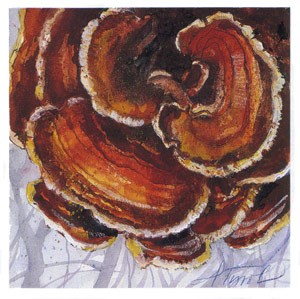
Last winter, I went on a photography binge, trying to get as many pictures of common and good looking fungus specimens as I could find in my neighborhood. I knew at the start that I was attracted to the turkey tail fungus but still was surprised to find that about a third of my many photos ended up being of turkey tails (Trametes versicolor) – big ones, small ones, small clusters, and huge aggregations.
The fan-shaped fruiting bodies of the turkey tail fungus have the same kind of concentric banding and roughly the same palette of colors as an actual turkey’s tail, but the fungal tails are far smaller, ranging from less than an inch to three inches across. Plus, no two are alike: there are softly banded ones and others with startlingly bold, contrasting colors in their bands. White, all the shades of brown and gray imaginable, plus brownish reds, oranges, and purples are possibilities; the variability is attributed to both a fungus’s genetic makeup and its environment.
Turkey tails are among the most common and most beautiful fungi in the woods. Often they fruit prolifically, completely covering a stump or downed tree trunk. Although you will almost always find them fruiting on dead wood, they do sometimes invade the sapwood of stressed trees and even have been reported to kill the cambium of apple trees.
A fungus has to be pretty specialized to overcome the defenses of a healthy, live tree, and the most harmful tree diseases, such as white pine blister rust or Dutch elm disease, succeed at invading only one or two tree species.
Turkey tails, on the other hand, are consummate generalists; they are found on more than 70 genera of hardwoods in the U.S. and occasionally attack conifers as well. The dead sapwood of most tree species has relatively little resistance to decay organisms, and turkey tails take advantage of this throughout the temperate zones of the world. Most of the time, the turkey tail decomposes dead wood, using enzymes to deconstruct cell walls.
Decomposition is essential to forest growth – otherwise, the pile of accumulated dead wood that would carpet the earth over the course of a few thousand years would be as effective as a glacier in eliminating most green plants. Fungi such as this one recycle all of it, making both nutrients and space available for trees and other organisms.
Fungi that succeed in making a living from wood vary in their ability to feed upon one or the other of its main constituents, cellulose and lignin. The turkey tail degrades lignin more rapidly than it does cellulose, and because the cellulosic residue is light in color, it is classed as a white rot, as opposed to the other main group, the cellulose eaters that produce red rot. At an advanced stage, wood decayed by the turkey tail tends to be white and stringy. Cellulose is the fraction of wood used in papermaking, and fungi such as turkey tails that can get rid of lignin while leaving cellulose relatively intact may someday help replace the chemicals now used to make paper. The turkey tail may also have a future as a clean-up agent because it has been found to degrade some of the pesticides that tend to persist in the environment.
Trametes versicolor, formerly known as Coriolus versicolor, is a member of the polypore family, along with about 100 other genera, all of which have tiny pores on the underside of the fruiting structures. The interior surface of each pore bears spores, and this arrangement allows for a very large spore-bearing surface area, which is equally effective at deploying vast numbers of spores as the gills found in many more familiar mushrooms.
Turkey tail fruiting bodies are thin and pliable when fresh. The pores on the white or cream-colored undersides are fairly easy see. The upper surface, in addition to being nicely colored, is velvety. There is a somewhat similarly shaped banded fungus, Stereum ostrea, the false turkey tail, but its undersurface has no pores and it has a tougher, more leathery texture.
Those of us who like to forage close to home might appreciate turkey tails on the dining table – not as food, but as table decorations during that lengthy spell between chrysanthemums and serviceberry known as winter.

